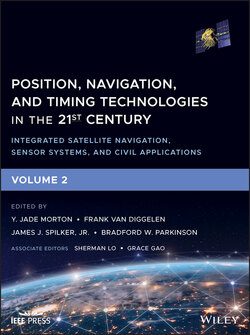Читать книгу Position, Navigation, and Timing Technologies in the 21st Century - Группа авторов - Страница 69
38.3 Clock Error Dynamics Modeling
ОглавлениеGNSS SVs are equipped with atomic clocks, are synchronized, and their clock errors are transmitted in the navigation message along with the SVs’ orbital elements. In contrast, cellular BTSs are equipped with less stable oscillators (typically OCXOs), are roughly synchronized to GNSS, and their clock error states (bias and drift) and positions are typically unknown. As such, the cellular BTSs’ clock errors and positions must be estimated. Therefore, it is important to model the clock error state dynamics. To this end, a typical model for the dynamics of the clock error states is the so‐called two‐state model, composed of the clock bias δt and clock drift , as depicted in Figure 38.2.
The clock error states evolve according to
Figure 38.2 Clock error states dynamics model.
Source: Z. Kassas, Analysis and synthesis of collaborative opportunistic navigation systems, Ph.D. Dissertation, The University of Texas at Austin, USA, May 2014. Reproduced with permission of Z. Kassas (University of Texas at Austin).
where the elements of are modeled as zero‐mean, mutually independent white noise processes, and the power spectral density of is given by . The power spectra and can be related to the power‐law coefficients , which have been shown through laboratory experiments to be adequate to characterize the power spectral density of the fractional frequency deviation y(t) of an oscillator from the nominal frequency, which takes the form [32, 33]. It is common to approximate the clock error dynamics by considering only the frequency random walk coefficient h−2 and the white frequency coefficient h0, which lead to and [34, 35]. Typical OCXO values for h0 and h−2 are given in Table 38.2.
Discretizing the dynamics (Eq. (38.1)) at a sampling interval T yields the discrete‐time‐equivalent model
where is a discrete‐time zero‐mean white noise sequence with covariance Qclk, and
Table 38.2 Typical h0 and h−2 values for different OCXOs [36]
Source: J. Curran, G. Lachapelle, and C. Murphy, “Digital GNSS PLL design conditioned on thermal and oscillator phase noise,” IEEE Transactions on Aerospace and Electronic Systems, vol. 48, no. 1, pp. 180–196, January 2012.
| h 0 | h −2 |
|---|---|
| 2.6 × 10−22 | 4.0 × 10−26 |
| 8.0 × 10−20 | 4.0 × 10−23 |
| 3.4 × 10−22 | 1.3 × 10−24 |
